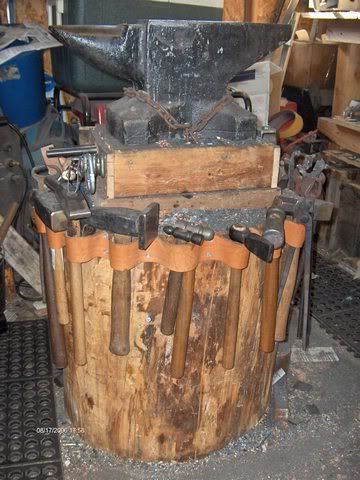|
|
|||||||
| Register | All Photos | FAQ | Members List | Calendar | ShopStream (Radio/TV) | Search | Today's Posts | Mark Forums Read |
| The Outpost This forum is dedicated to all who share a love for, and a desire to make good knives, and have fun doing it. We represent a diverse group of smiths and knifemakers who bring numerous methods to their craft. |
 |
|
|
Thread Tools | Display Modes |
|
#1
|
||||
|
||||
|
Mounting New Anvil?
I plan to attach my new 70lb anvil to an 80lb+/- piece of mild steel by drilling and tapping the plate and using straps across the anvil feet. Would I gain any advantage by using JB weld between the plate and the anvil?
The anvil stand will be made of 12"X12" MDF stacked and held together with two 1/2" all thread rods running vertically through the pieces. The thought is to be able to adjust the height by adding or removing pieces. Comments and suggestions would be greatly appreciated. __________________ Mike Broach Knives made to be used. |
|
#2
|
||||
|
||||
|
You may want to hold off on the JB weld. After I got my anvil I changed the stand three times before I got the right base for it. You will very likely have to try a few bases for it before you find one that will work right. The last thing you want to do is have to pry it loose from JB weld.
 How an anvil is mounted varies according to each person. I finally settled with a 20" doug fir round that weighs more then the anvil does. It seems like there are as many ways to mount one as there are forgers. Don't do anything too permanent that you will regret. This is the mount I finally settled on. Over on Bladeforums.com this topic filled up four pages of post's. There are alot of options so be sure to try several of them.  Make sure you dump a bucket or two of heat scale around it so it looks like you have been using it. Last edited by B.Finnigan; 08-17-2006 at 08:00 PM. |
|
#3
|
|||
|
|||
|
lol
"Make sure you dump a bucket or two of heat scale around it so it looks like you have been using it."
:rofl |
|
#4
|
||||
|
||||
|
I would not recommend stacking sheets of MDF, I doubt you could get it tight enough not to bounce or compress with each hammer blow.
The idea is to have the anvil basically become part of the earth, you don't want it to move at all beyond the inherent resilience of the anvil itself. Any other movement just saps energy that should be going into your work. I don't think the JB weld will hurt anything, but I'd use silicone caulk, it'd quiet the ring more. Farrier's anvils like that have a tendency to pierce your eardrums if not solidly clamped! 
|
|
#5
|
||||
|
||||
|
There are a million ways to mount an anvil, I agree. However, I have never been a fan of mounting an anvil on metal. It takes away the ability of the mounting base to absorb shock. Therefore the anvil takes it all and has a chance of breaking (Yes they can break).
I was taught that an anvil "properly" mounted was mounted on a log that was burried in the ground. You were to stand upright with your arm hanging down and your hand in a fist. You measured from your knuckles to the ground. If the distance was, for example 30" you had to have 30" or more in the ground and 30" (minus the height of your anvil) above the ground. This gave a solid but forgiving base for the anvil. The reason for measurning from a closed fist was to have the ancvil at a height that your arm could extend when forging and you did not have to bend over excessively. Now, this is what I learned from a blacksmith friend of mine that has been a full time blacksmith his entire working life. Everyone has their own opinion. I personally think it makes sense. My anvil is 75lbs and mounted on 6 4x4's bolted together and concreted into a shortened barrel with a sand base. I have used it to forge with a striker using a sledge hammer with both hands and getting after it and my anvil is in great shape so I think that there should be some forgiveness by the base but very little. I would not try to eliminate ALL forgiveness in the base. Just my .02 |
 |
| Tags |
| forge, forging |
| Currently Active Users Viewing This Thread: 1 (0 members and 1 guests) | |
| Thread Tools | |
| Display Modes | |
|
|